
/ 今日科技快讯 /
近日,一些国家的黑客频繁对俄罗斯发动网络攻击,以阻止它们正常运行。未来几天,俄罗斯可能与全球互联网断开。针对网络威胁,俄罗斯政府准备启动自己的“大局域网”Runet。俄联邦消费者权益保护和公益监督局称,目前正在与国家计算机事故协调中心进行协调,以应对黑客对关键信息基础设施的攻击,并做好启用Runet的准备。
/ 作者简介 /
本篇文章来自8K吃萝卜的投稿,文章主要分享了如何进行字节码插桩,相信会对大家有所帮助!同时也感谢作者贡献的精彩文章。
8K吃萝卜的博客地址:
https://juejin.cn/user/1151943917189511
/ 前言 /
使用GradlePlugin、Transform和ASM实现字节码插桩,GradlePlugin相关代码全部由Kotlin编写,所以不熟悉groovy的小伙伴也可以无障碍阅读。
/ 什么是字节码插桩 /
要了解字节码插桩,首先要了解AOP(Aspect Oriented Programming)思想,对比来说,OOP(面向对象编程)主要针对的是业务处理过程的实体极其属性和行为进行抽象封装,为的是有更清晰高效的逻辑单元划分。AOP(面向切面编程)则是针对业务处理过程中的切面进行提取,它所面对的是处理过程中的某个步骤或阶段,以获得逻辑过程中各部分之间低耦合的隔离效果。
字节码插入位置
Android开发者应该会熟悉这个图片(来自于Android Developer):

在Compilers中具体为:

字节码插桩就是在.class文件转为.dex之前,修改.class文件从而达到修改代码的目的。
业务场景
字节码插桩可以用于日志记录、性能统计、异常处理、修改三方库代码等。
需要掌握的知识
在Android项目中使用字节码插桩,你要掌握
GradlePlugin相关知识
了解Transform API
了解字ASM,Javassist或者其他相关插桩框架
/ 创建你的GradlePlugin /
GradlePlugin相关知识也可以直接参考官网文档。
创建的三种方式
直接在相应model的build.gradle里面写相应的plugin代码(方式直接,但是作用范围只有单个model)。
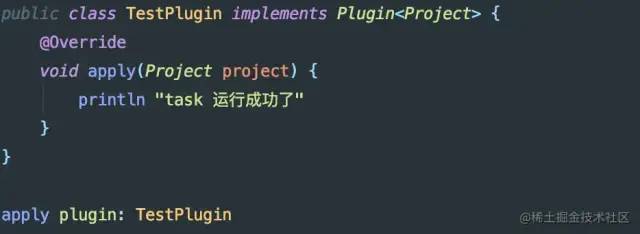
在buildSrc里面写plugin代码(作用范围是整个工程)。
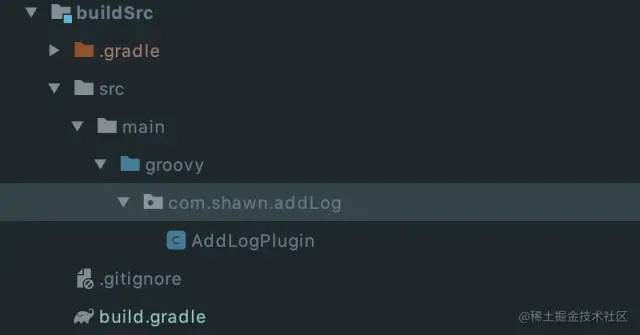

创建plugin模块,写资源文件xxx.properties文件确定plugin名字以及文件对应地址(相比前两个实现方式较为复杂,但是可以上传到公共仓库多项目复用)。

在properties文件中标出模块文件位置:
properties文件

引入模块的名字:properties文件的文件名(例子中为com.shawn.addlogformethodplugin)。
build.gradle

引入maven库方便本地调试。
使用plugin
在第一种方式中plugin为默认包名,可以直接引用。

第二种方式中根据自己定义的包名引入。

第三种方式首先在项目根目录下引入仓库,再引用根目录下build.gradle。
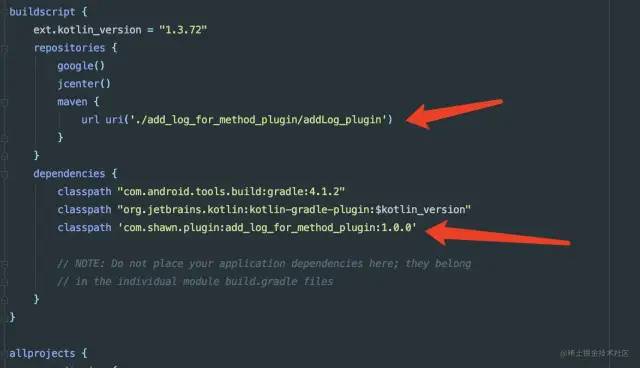
model里面build.gradle。

/ 了解Transform /
什么是Transform
从1.5.0-beta1开始,Gradle插件包含一个Transform API,允许第三方插件在将已编译的类文件转换为dex文件之前对其进行操作。(该API已存在于1.4.0-beta2中,但已在1.5.0-beta1中进行了彻底的改进)
Transform的工作原理
类似于OkHttp的拦截器,采用责任链模式。每一个Transform都是一个Task,编译中间产物在多个Transform链上传递。用户自定一的Transform会在链头第一个执行,由于每一个Transform的处理源都是由前一个Transform提供的,所以如果用户自定义的Transform没有把相应的文件搬运到指定输出位置,那么下一个Transform就无法正常工作。

Transform相关方法
getName()
/**
* Returns the unique name of the transform.
*
* <p>This is associated with the type of work that the transform does. It does not have to be
* unique per variant.
*/
@NonNull
public abstract String getName();表示当前Transform名称,这个名称会被用来创建目录,它会出现在app/build/intermediates/transforms目录下。
getInputTypes()
/**
* Returns the type(s) of data that is consumed by the Transform. This may be more than
* one type.
*
* <strong>This must be of type {@link QualifiedContent.DefaultContentType}</strong>
*/
@NonNull
public abstract Set<ContentType> getInputTypes();需要处理的数据类型,用于确定我们需要对哪些类型的结果进行修改,比如class,资源文件等。

getScopes()
/**
* Returns the scope(s) of the Transform. This indicates which scopes the transform consumes.
*/
@NonNull
public abstract Set<? super Scope> getScopes();表示Transform要操作的内容范围。

这些Scope可以自由组合使用(比如SCOPE_FULL_PROJECT包含了Scope.PROJECT,Scope.SUB_PROJECTS,Scope.EXTERNAL_LIBRARIES)。
isIncremental()
/**
* Returns whether the Transform can perform incremental work.
*
* <p>If it does, then the TransformInput may contain a list of changed/removed/added files, unless
* something else triggers a non incremental run.
*/
public abstract boolean isIncremental();是否支持增量更新:如果返回true,则TransformInput会包含一份修改的文件列表,如果返回false,则进行全量编译,删除上一次输出的内容。
相关状态说明:
NOTCHANGED:不需要做任何处理。
REMOVED:需要移除文件。
ADDED、CHANGED:需要正常修改文件。
transform()
/**
* Executes the Transform.
*
* <p>The inputs are packaged as an instance of {@link TransformInvocation}
* <ul>
* <li>The <var>inputs</var> collection of {@link TransformInput}. These are the inputs
* that are consumed by this Transform. A transformed version of these inputs must
* be written into the output. What is received is controlled through
* {@link #getInputTypes()}, and {@link #getScopes()}.</li>
* <li>The <var>referencedInputs</var> collection of {@link TransformInput}. This is
* for reference only and should be not be transformed. What is received is controlled
* through {@link #getReferencedScopes()}.</li>
* </ul>
*
* A transform that does not want to consume anything but instead just wants to see the content
* of some inputs should return an empty set in {@link #getScopes()}, and what it wants to
* see in {@link #getReferencedScopes()}.
*
* <p>Even though a transform's {@link Transform#isIncremental()} returns true, this method may
* be receive <code>false</code> in <var>isIncremental</var>. This can be due to
* <ul>
* <li>a change in secondary files ({@link #getSecondaryFiles()},
* {@link #getSecondaryFileOutputs()}, {@link #getSecondaryDirectoryOutputs()})</li>
* <li>a change to a non file input ({@link #getParameterInputs()})</li>
* <li>an unexpected change to the output files/directories. This should not happen unless
* tasks are improperly configured and clobber each other's output.</li>
* <li>a file deletion that the transform mechanism could not match to a previous input.
* This should not happen in most case, except in some cases where dependencies have
* changed.</li>
* </ul>
* In such an event, when <var>isIncremental</var> is false, the inputs will not have any
* incremental change information:
* <ul>
* <li>{@link JarInput#getStatus()} will return {@link Status#NOTCHANGED} even though
* the file may be added/changed.</li>
* <li>{@link DirectoryInput#getChangedFiles()} will return an empty map even though
* some files may be added/changed.</li>
* </ul>
*
* @param transformInvocation the invocation object containing the transform inputs.
* @throws IOException if an IO error occurs.
* @throws InterruptedException
* @throws TransformException Generic exception encapsulating the cause.
*/
public void transform(@NonNull TransformInvocation transformInvocation)
throws TransformException, InterruptedException, IOException {
// Just delegate to old method, for code that uses the old API.
//noinspection deprecation
transform(transformInvocation.getContext(), transformInvocation.getInputs(),
transformInvocation.getReferencedInputs(),
transformInvocation.getOutputProvider(),
transformInvocation.isIncremental());
}在这里可以获取到getInputs(),如果消费了getInputs()的话,则transform后必须输出给下一级,不然下一级读取不到编译中间件。是否增量编译要以isIncremental为准。
override fun transform(transformInvocation: TransformInvocation?) {
val inputs = transformInvocation?.inputs
val out = transformInvocation?.outputProvider
inputs?.forEach { transformInput ->
//项目目录
transformInput.directoryInputs.forEach { directoryInput ->
if (directoryInput.file.isDirectory) {
FileUtils.getAllFiles(directoryInput.file).forEach {
val file = it
val name = file.name
if (name.endsWith(".class") && name != "R.class" && !name.startsWith("R\$") && name != "BuildConfig.class") {
val classPath = file.absolutePath
val cr = ClassReader(file.readBytes())
val cw = ClassWriter(cr, ClassWriter.COMPUTE_MAXS)
val visitor = AddLogClassVisitor(cw)
cr.accept(visitor, ClassReader.EXPAND_FRAMES)
val byte = cw.toByteArray();
val fos = FileOutputStream(classPath)
fos.write(byte)
fos.close()
}
}
}
val dest = out?.getContentLocation(
directoryInput.name,
directoryInput.contentTypes,
directoryInput.scopes,
Format.DIRECTORY
)
FileUtils.copyDirectoryToDirectory(directoryInput.file, dest)
}
//jar包
transformInput.jarInputs.forEach {
val dest = out?.getContentLocation(
it.name,
it.contentTypes,
it.scopes,
Format.JAR
)
FileUtils.copyFile(it.file, dest)
}
}
}/ ASM实践方案 /
字节码相关知识请自行查看,本文不做过多讲解。
ASM核心API
ASM Core API可以类比解析XML文件中的SAX方式,不需要把这个类的整个结构读取进来,就可以用流式的方法来处理字节码文件。好处是非常节约内存,但是编程难度较大。然而出于性能考虑,一般情况下编程都使用Core API。在Core API中有以下几个关键类:
ClassReader:用于读取已经编译好的.class文件。
ClassWriter:用于重新构建编译后的类,生成新的类的字节码文件。
各种Visitor类:CoreAPI根据字节码从上到下依次处理,对于字节码文件中不同的区域有不同的Visitor,比如用于访问方法的MethodVisitor、用于访问类变量的FieldVisitor、用于访问注解的AnnotationVisitor等。为了实现AOP,重点要使用的是MethodVisitor。
情景目标
要给MainActivity.kt中所有的方法添加一个自定义方法的调用。
首先在transform()方法中读取想要修改的class文件。创建ClassVisitor类并且传入ClassWriter用于字节码定位修改操作,把ClassVisitor传入ClassReader用于重新构建新的字节码文件。
val classPath = file.absolutePath
val cr = ClassReader(file.readBytes())
val cw = ClassWriter(cr, ClassWriter.COMPUTE_MAXS)
val visitor = AddLogClassVisitor(cw)
cr.accept(visitor, ClassReader.EXPAND_FRAMES)
val byte = cw.toByteArray()
val fos = FileOutputStream(classPath)
fos.write(byte)
fos.close()编写自定义Visitor类继承于ClassVisitor,实现方法定位。
visit()方法可以拿到类的相关信息:
public void visit(
final int version,
final int access,
final String name,
final String signature,
final String superName,
final String[] interfaces) {
if (cv != null) {
cv.visit(version, access, name, signature, superName, interfaces);
}
}visitMethod()方法可以遍历所有方法信息,用于定位需要修改的方法。
public MethodVisitor visitMethod(
final int access,
final String name,
final String descriptor,
final String signature,
final String[] exceptions) {
if (cv != null) {
return cv.visitMethod(access, name, descriptor, signature, exceptions);
}
return null;
}在这里找到通过名字判断定位目标方法:
AddLogClassVisitor.kt
class AddLogClassVisitor(classVisitor: ClassVisitor) : ClassVisitor(Opcodes.ASM7, classVisitor) {
private var className: String? = null
override fun visit(
version: Int,
access: Int,
name: String?,
signature: String?,
superName: String?,
interfaces: Array<out String>?
) {
super.visit(version, access, name, signature, superName, interfaces)
className = name
println("className = $className")
}
override fun visitMethod(
access: Int,
name: String?,
descriptor: String?,
signature: String?,
exceptions: Array<out String>?
): MethodVisitor {
val methodVisitor = super.visitMethod(access, name, descriptor, signature, exceptions)
println("method = $name")
if (className.equals("com/shawn/krouter/MainActivity") && name != "<init>") {
return if (name == "onCreate") {
AddLogInitMethodVisitor(methodVisitor)
} else {
AddLogMethodVisitor(methodVisitor)
}
}
return methodVisitor
}
}编写自定义Visitor类继承于MethodVisitor,进行字节码修改。
在visitCode()方法中的字节码会插入到方法执行之前。
/** Starts the visit of the method's code, if any (i.e. non abstract method). */
public void visitCode() {
if (mv != null) {
mv.visitCode();
}
}在visitInsn(opcode: Int)方法中当opcode == ARETURN || opcode == RETURN的时候,插入的字节码会插入到方法后面。
/**
* Visits a zero operand instruction.
*
* @param opcode the opcode of the instruction to be visited. This opcode is either NOP,
* ACONST_NULL, ICONST_M1, ICONST_0, ICONST_1, ICONST_2, ICONST_3, ICONST_4, ICONST_5,
* LCONST_0, LCONST_1, FCONST_0, FCONST_1, FCONST_2, DCONST_0, DCONST_1, IALOAD, LALOAD,
* FALOAD, DALOAD, AALOAD, BALOAD, CALOAD, SALOAD, IASTORE, LASTORE, FASTORE, DASTORE,
* AASTORE, BASTORE, CASTORE, SASTORE, POP, POP2, DUP, DUP_X1, DUP_X2, DUP2, DUP2_X1, DUP2_X2,
* SWAP, IADD, LADD, FADD, DADD, ISUB, LSUB, FSUB, DSUB, IMUL, LMUL, FMUL, DMUL, IDIV, LDIV,
* FDIV, DDIV, IREM, LREM, FREM, DREM, INEG, LNEG, FNEG, DNEG, ISHL, LSHL, ISHR, LSHR, IUSHR,
* LUSHR, IAND, LAND, IOR, LOR, IXOR, LXOR, I2L, I2F, I2D, L2I, L2F, L2D, F2I, F2L, F2D, D2I,
* D2L, D2F, I2B, I2C, I2S, LCMP, FCMPL, FCMPG, DCMPL, DCMPG, IRETURN, LRETURN, FRETURN,
* DRETURN, ARETURN, RETURN, ARRAYLENGTH, ATHROW, MONITORENTER, or MONITOREXIT.
*/
public void visitInsn(final int opcode) {
if (mv != null) {
mv.visitInsn(opcode);
}
}我们在这里插入需要的字节码:
AddLogMethodVisitor.kt
class AddLogMethodVisitor(methodVisitor: MethodVisitor) :
MethodVisitor(Opcodes.ASM7, methodVisitor) {
override fun visitCode() {
super.visitCode()
//方法执行前插入
mv.visitLdcInsn("AddLogMethodPlugin")
mv.visitTypeInsn(Opcodes.NEW, "java/lang/StringBuilder")
mv.visitInsn(Opcodes.DUP)
mv.visitMethodInsn(
Opcodes.INVOKESPECIAL,
"java/lang/StringBuilder",
"<init>",
"()V",
false
)
mv.visitLdcInsn("into ")
mv.visitMethodInsn(
Opcodes.INVOKEVIRTUAL,
"java/lang/StringBuilder",
"append",
"(Ljava/lang/String;)Ljava/lang/StringBuilder;",
false
)
mv.visitTypeInsn(Opcodes.NEW, "java/lang/Exception")
mv.visitInsn(Opcodes.DUP)
mv.visitMethodInsn(Opcodes.INVOKESPECIAL, "java/lang/Exception", "<init>", "()V", false)
mv.visitMethodInsn(
Opcodes.INVOKEVIRTUAL,
"java/lang/Exception",
"getStackTrace",
"()[Ljava/lang/StackTraceElement;",
false
)
mv.visitInsn(Opcodes.ICONST_0)
mv.visitInsn(Opcodes.AALOAD)
mv.visitMethodInsn(
Opcodes.INVOKEVIRTUAL,
"java/lang/StackTraceElement",
"getMethodName",
"()Ljava/lang/String;",
false
)
mv.visitMethodInsn(
Opcodes.INVOKEVIRTUAL,
"java/lang/StringBuilder",
"append",
"(Ljava/lang/String;)Ljava/lang/StringBuilder;",
false
)
mv.visitMethodInsn(
Opcodes.INVOKEVIRTUAL,
"java/lang/StringBuilder",
"toString",
"()Ljava/lang/String;",
false
)
mv.visitMethodInsn(
Opcodes.INVOKESTATIC,
"com/shawn/krouter/uitl/UtilsKt",
"MyLogD",
"(Ljava/lang/String;Ljava/lang/String;)V",
false
)
}
override fun visitInsn(opcode: Int) {
//方法后插入
super.visitInsn(opcode)
}
}把plugin编译出来,然后引入相应model中,便可以实现需求。
查看class文件,可以看到插入字节码成功。
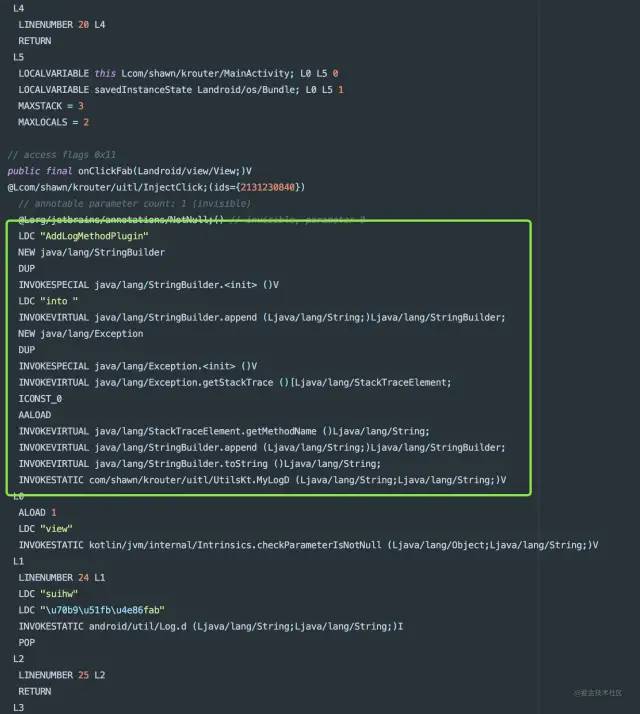
log输出

轻松的生成插入代码
在很多网络文章中都会推荐使用ASM Bytecode Outline插件来查看字节码,但是这个插件目前只可以安装在Intellij IDEA,Android studio无法安装,这边找到ASM Bytecode Viewer这个插件也可以达到同样的效果,可以让我们更加方便的插入字节码。
首先编写Test.java类,编译称.class,然后用ASM Bytecode Viewer插件来查看相关ASM代码。
Test.java
package com.shawn.krouter;
import android.util.Log;
import com.shawn.krouter.uitl.UtilsKt;
public class Test {
String name = "testFun";
public void TestFun(){
Log.d("suihw","lalala");
}
}通过插件查看ASM相关代码:
package asm.com.shawn.krouter;
import org.objectweb.asm.AnnotationVisitor;
import org.objectweb.asm.Attribute;
import org.objectweb.asm.ClassReader;
import org.objectweb.asm.ClassWriter;
import org.objectweb.asm.ConstantDynamic;
import org.objectweb.asm.FieldVisitor;
import org.objectweb.asm.Handle;
import org.objectweb.asm.Label;
import org.objectweb.asm.MethodVisitor;
import org.objectweb.asm.Opcodes;
import org.objectweb.asm.Type;
import org.objectweb.asm.TypePath;
public class TestDump implements Opcodes {
public static byte[] dump() throws Exception {
ClassWriter classWriter = new ClassWriter(0);
FieldVisitor fieldVisitor;
MethodVisitor methodVisitor;
AnnotationVisitor annotationVisitor0;
classWriter.visit(V1_8, ACC_PUBLIC | ACC_SUPER, "com/shawn/krouter/Test", null, "java/lang/Object", null);
classWriter.visitSource("Test.java", null);
{
methodVisitor = classWriter.visitMethod(ACC_PUBLIC, "<init>", "()V", null, null);
methodVisitor.visitCode();
Label label0 = new Label();
methodVisitor.visitLabel(label0);
methodVisitor.visitLineNumber(5, label0);
methodVisitor.visitVarInsn(ALOAD, 0);
methodVisitor.visitMethodInsn(INVOKESPECIAL, "java/lang/Object", "<init>", "()V", false);
methodVisitor.visitInsn(RETURN);
Label label1 = new Label();
methodVisitor.visitLabel(label1);
methodVisitor.visitLocalVariable("this", "Lcom/shawn/krouter/Test;", null, label0, label1, 0);
methodVisitor.visitMaxs(1, 1);
methodVisitor.visitEnd();
}
{
methodVisitor = classWriter.visitMethod(ACC_PUBLIC, "TestFun", "()V", null, null);
methodVisitor.visitCode();
Label label0 = new Label();
methodVisitor.visitLabel(label0);
methodVisitor.visitLineNumber(7, label0);
methodVisitor.visitLdcInsn("suihw");
methodVisitor.visitLdcInsn("lalala");
methodVisitor.visitMethodInsn(INVOKESTATIC, "android/util/Log", "d", "(Ljava/lang/String;Ljava/lang/String;)I", false);
methodVisitor.visitInsn(POP);
Label label1 = new Label();
methodVisitor.visitLabel(label1);
methodVisitor.visitLineNumber(8, label1);
methodVisitor.visitInsn(RETURN);
Label label2 = new Label();
methodVisitor.visitLabel(label2);
methodVisitor.visitLocalVariable("this", "Lcom/shawn/krouter/Test;", null, label0, label2, 0);
methodVisitor.visitMaxs(2, 1);
methodVisitor.visitEnd();
}
classWriter.visitEnd();
return classWriter.toByteArray();
}
}修改Test.java类,把想要插入的相关java代码写好,然后在编译成.class文件。修改后的Test.java:
package com.shawn.krouter;
import android.util.Log;
import com.shawn.krouter.uitl.UtilsKt;
public class Test {
String name = "testFun";
public void TestFun(){
UtilsKt.MyLogD("suihw","into " + new Exception().getStackTrace()[0].getMethodName());
Log.d("suihw","lalala");
}
}通过插件查看ASM相关代码:
package asm.com.shawn.krouter;
import org.objectweb.asm.AnnotationVisitor;
import org.objectweb.asm.Attribute;
import org.objectweb.asm.ClassReader;
import org.objectweb.asm.ClassWriter;
import org.objectweb.asm.ConstantDynamic;
import org.objectweb.asm.FieldVisitor;
import org.objectweb.asm.Handle;
import org.objectweb.asm.Label;
import org.objectweb.asm.MethodVisitor;
import org.objectweb.asm.Opcodes;
import org.objectweb.asm.Type;
import org.objectweb.asm.TypePath;
public class TestDump implements Opcodes {
public static byte[] dump() throws Exception {
ClassWriter classWriter = new ClassWriter(0);
FieldVisitor fieldVisitor;
MethodVisitor methodVisitor;
AnnotationVisitor annotationVisitor0;
classWriter.visit(V1_8, ACC_PUBLIC | ACC_SUPER, "com/shawn/krouter/Test", null, "java/lang/Object", null);
classWriter.visitSource("Test.java", null);
{
methodVisitor = classWriter.visitMethod(ACC_PUBLIC, "<init>", "()V", null, null);
methodVisitor.visitCode();
Label label0 = new Label();
methodVisitor.visitLabel(label0);
methodVisitor.visitLineNumber(7, label0);
methodVisitor.visitVarInsn(ALOAD, 0);
methodVisitor.visitMethodInsn(INVOKESPECIAL, "java/lang/Object", "<init>", "()V", false);
methodVisitor.visitInsn(RETURN);
Label label1 = new Label();
methodVisitor.visitLabel(label1);
methodVisitor.visitLocalVariable("this", "Lcom/shawn/krouter/Test;", null, label0, label1, 0);
methodVisitor.visitMaxs(1, 1);
methodVisitor.visitEnd();
}
{
methodVisitor = classWriter.visitMethod(ACC_PUBLIC, "TestFun", "()V", null, null);
methodVisitor.visitCode();
Label label0 = new Label();
methodVisitor.visitLabel(label0);
methodVisitor.visitLineNumber(9, label0);
methodVisitor.visitLdcInsn("suihw");
methodVisitor.visitTypeInsn(NEW, "java/lang/StringBuilder");
methodVisitor.visitInsn(DUP);
methodVisitor.visitMethodInsn(INVOKESPECIAL, "java/lang/StringBuilder", "<init>", "()V", false);
methodVisitor.visitLdcInsn("into ");
methodVisitor.visitMethodInsn(INVOKEVIRTUAL, "java/lang/StringBuilder", "append", "(Ljava/lang/String;)Ljava/lang/StringBuilder;", false);
methodVisitor.visitVarInsn(ALOAD, 0);
methodVisitor.visitMethodInsn(INVOKEVIRTUAL, "java/lang/Object", "getClass", "()Ljava/lang/Class;", false);
methodVisitor.visitMethodInsn(INVOKEVIRTUAL, "java/lang/Class", "getSimpleName", "()Ljava/lang/String;", false);
methodVisitor.visitMethodInsn(INVOKEVIRTUAL, "java/lang/StringBuilder", "append", "(Ljava/lang/String;)Ljava/lang/StringBuilder;", false);
methodVisitor.visitMethodInsn(INVOKEVIRTUAL, "java/lang/StringBuilder", "toString", "()Ljava/lang/String;", false);
methodVisitor.visitMethodInsn(INVOKESTATIC, "com/shawn/krouter/uitl/UtilsKt", "MyLogD", "(Ljava/lang/String;Ljava/lang/String;)V", false);
Label label1 = new Label();
methodVisitor.visitLabel(label1);
methodVisitor.visitLineNumber(10, label1);
methodVisitor.visitLdcInsn("suihw");
methodVisitor.visitLdcInsn("lalala");
methodVisitor.visitMethodInsn(INVOKESTATIC, "android/util/Log", "d", "(Ljava/lang/String;Ljava/lang/String;)I", false);
methodVisitor.visitInsn(POP);
Label label2 = new Label();
methodVisitor.visitLabel(label2);
methodVisitor.visitLineNumber(11, label2);
methodVisitor.visitInsn(RETURN);
Label label3 = new Label();
methodVisitor.visitLabel(label3);
methodVisitor.visitLocalVariable("this", "Lcom/shawn/krouter/Test;", null, label0, label3, 0);
methodVisitor.visitMaxs(3, 1);
methodVisitor.visitEnd();
}
classWriter.visitEnd();
return classWriter.toByteArray();
}
}找到异同处,便是我们需要的相关字节码,复制插入,便可以实现。
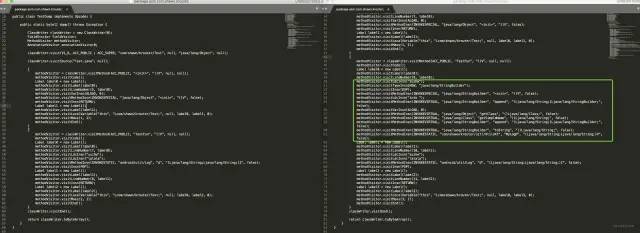
/ 彩蛋 /
buildSrc统一版本控制
官方介绍:
https://docs.gradle.org/current/userguide/organizing_gradle_projects.html#sec:build_sources
buildSrc模块会在整个项目编译最前执行,比项目根目录下build.gradle执行还要早,所以可以用来做统一版本控制,还会有代码提示,十分方便实用。
项目结构
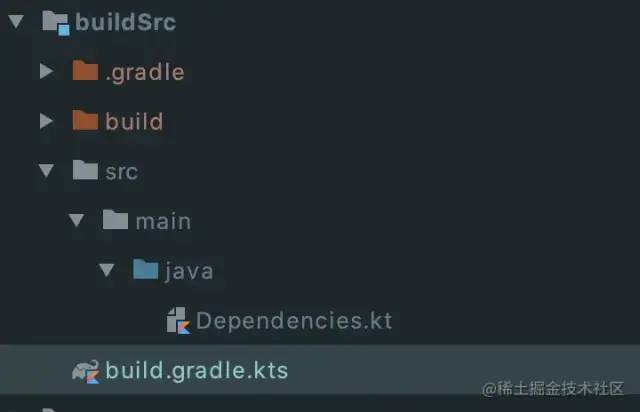
build.gradle.kts

Dependencies.kt

在相关模块中引入:
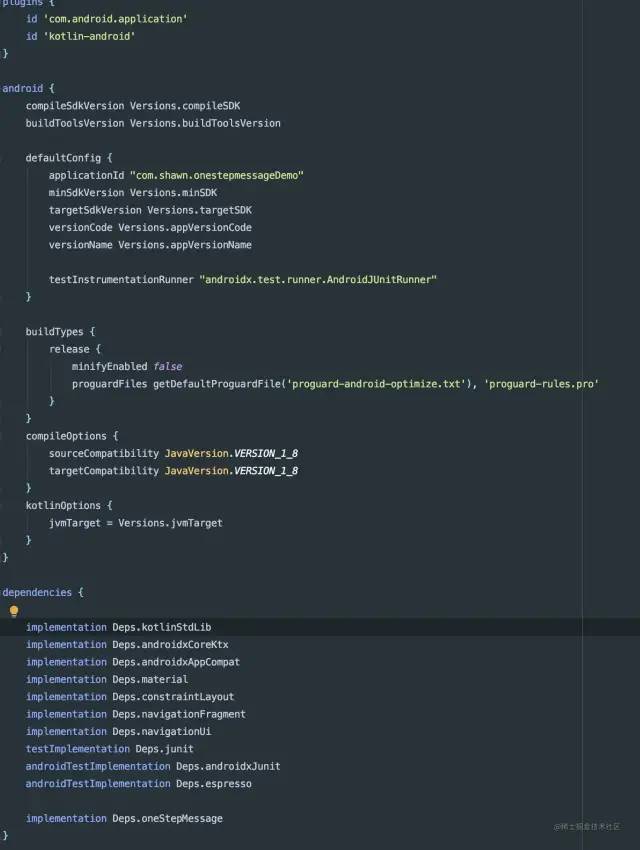
项目地址如下所示:
https://github.com/8kEatRadish/AOP_Demo
推荐阅读:
再学一遍android:fitsSystemWindows属性
欢迎关注我的公众号
学习技术或投稿


长按上图,识别图中二维码即可关注





















 539
539











 被折叠的 条评论
为什么被折叠?
被折叠的 条评论
为什么被折叠?








